The Critical Role of Temperature Control in Mortuary Care
Mortuary cooling systems are specialized refrigeration units designed to preserve human remains by maintaining temperatures between 36-39°F (2-4°C). These systems are essential for:
- Preservation: Slowing decomposition processes by 2-3 times compared to room temperature
- Dignity: Maintaining the physical appearance of the deceased for viewings and services
- Public Health: Preventing the spread of pathogens and controlling odors
- Compliance: Meeting regulatory requirements for funeral establishments
- Flexibility: Providing options for different facility sizes and needs
When a death occurs, cooling should ideally begin within 4-6 hours to effectively slow decomposition. Most facilities use walk-in coolers, body boxes, or newer technologies like direct-contact cooling systems depending on their specific requirements and capacity needs.
I'm Mortuary Cooler, a national-level supplier of mortuary cooling systems with extensive experience designing and implementing customized refrigeration solutions for funeral homes, hospitals, and medical examiners across the United States. My expertise in mortuary cooling systems has helped countless facilities maintain dignified care while meeting strict temperature control requirements.
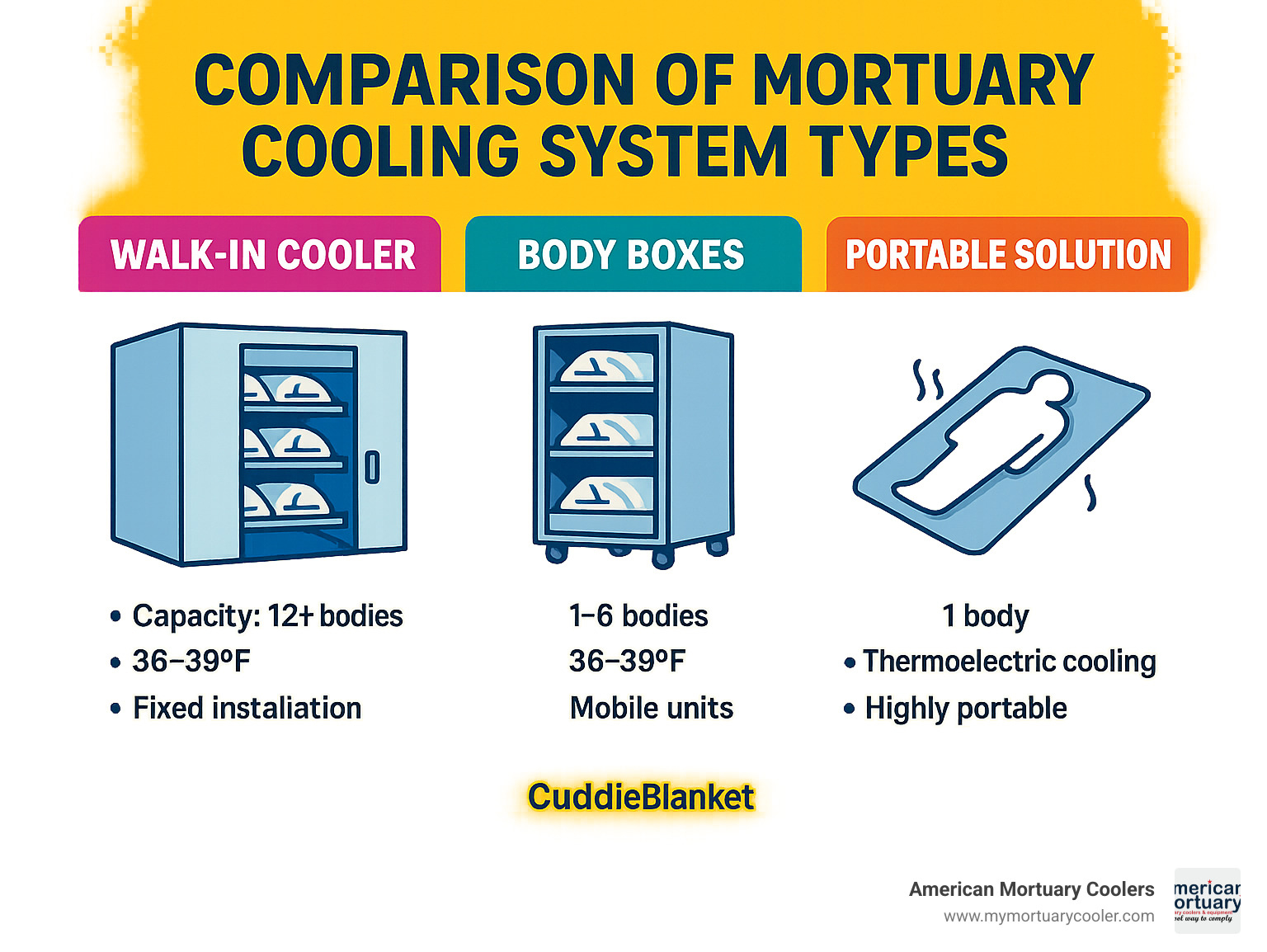
Learn more about Mortuary cooling systems:
Mortuary Cooling Systems 101: Why Temperature Matters
The science behind mortuary cooling systems isn't complicated, but it is fascinating. Think about what happens when life ends – the body's natural processes don't simply stop; they continue, just in a different way. Without the regulatory mechanisms that keep a living system in balance, the body begins to change through autolysis (where cells essentially digest themselves) and bacterial growth.
Temperature control is our most powerful tool for managing these natural processes. The industry standard range of 36-39°F (2-4°C) isn't arbitrary – it's carefully chosen for very specific reasons:

This "goldilocks zone" is cold enough to significantly slow bacterial growth and enzymatic activity, but not so cold that it causes freezing damage to tissues. It maintains the body in a condition that allows for proper embalming when needed and provides a safe, comfortable working environment for the professionals providing care.
According to NHS guidance for staff responsible for care after death, cooling should ideally begin within 4-6 hours after death. This timeline isn't just a suggestion – it represents a critical window during which we can effectively slow decomposition before significant changes occur.
At American Mortuary Coolers, we understand this delicate balance. That's why our systems feature precise digital temperature controls that maintain this narrow temperature band consistently, even when the cooler door is frequently opened or when outside temperatures fluctuate.
How Mortuary Cooling Systems Slow Decomposition
When life ends, two main processes begin immediately: autolysis and putrefaction.
Autolysis happens when the body's own enzymes begin breaking down cells from within – like a final act of cellular housekeeping. At the same time, bacteria (mostly from the intestines) begin to multiply and spread throughout the body in a process called putrefaction.
Mortuary cooling systems directly impact both processes by creating an environment where enzymatic activity dramatically slows and bacterial reproduction rates significantly decrease. While cellular breakdown continues, the pace becomes much more manageable.
Humidity is often overlooked, but it's just as important as temperature. Too much moisture accelerates bacterial growth, while too little can cause tissues to dry out inappropriately. Our cooling systems are designed to balance both temperature and humidity for optimal preservation.
The first 4 hours after death are particularly crucial because cellular breakdown accelerates as time passes. The sooner cooling begins, the more effective it will be – which explains why portable cooling solutions have become increasingly valuable, allowing preservation to begin at the place of death rather than waiting for transportation to a funeral facility.
Regulatory Temperature Requirements for Mortuary Cooling Systems
Providing proper care for the deceased isn't just about dignity and respect – it's also a matter of public health, worker safety, and regulatory compliance. While specific requirements vary depending on where you're located, several common standards apply to mortuary cooling systems:
OSHA regulations focus primarily on creating a safe environment for workers, including proper temperature monitoring and ventilation. CDC guidelines address critical infection control measures and prevention of disease transmission. State funeral boards often mandate specific temperature ranges, while local health departments may impose additional requirements based on regional needs.
The National Association of Funeral Directors guidance reinforces the industry standard of maintaining temperatures between 36-39°F (2-4°C). This range hasn't been chosen arbitrarily – it represents decades of practical experience and scientific research identifying the optimal conditions for preservation without freezing.
For a company like American Mortuary Coolers, with customers spanning from Tennessee to California, understanding these varying requirements is essential. That's why our systems are designed to meet or exceed even the most stringent requirements nationwide, ensuring compliance regardless of location.
When mortuary inspections occur, authorities typically pay close attention to temperature monitoring capabilities, backup systems for power failures, appropriate capacity for the facility's needs, and proper sanitation procedures. Our cooling systems are designed with these inspection points in mind, helping our customers maintain compliance while providing the highest standard of care.
Comparing Cooler Types, Technologies & Innovations
The world of mortuary cooling systems has come a long way in recent years. From traditional walk-in coolers to innovative portable solutions, today's funeral professionals have more options than ever to provide dignified care while meeting practical needs.
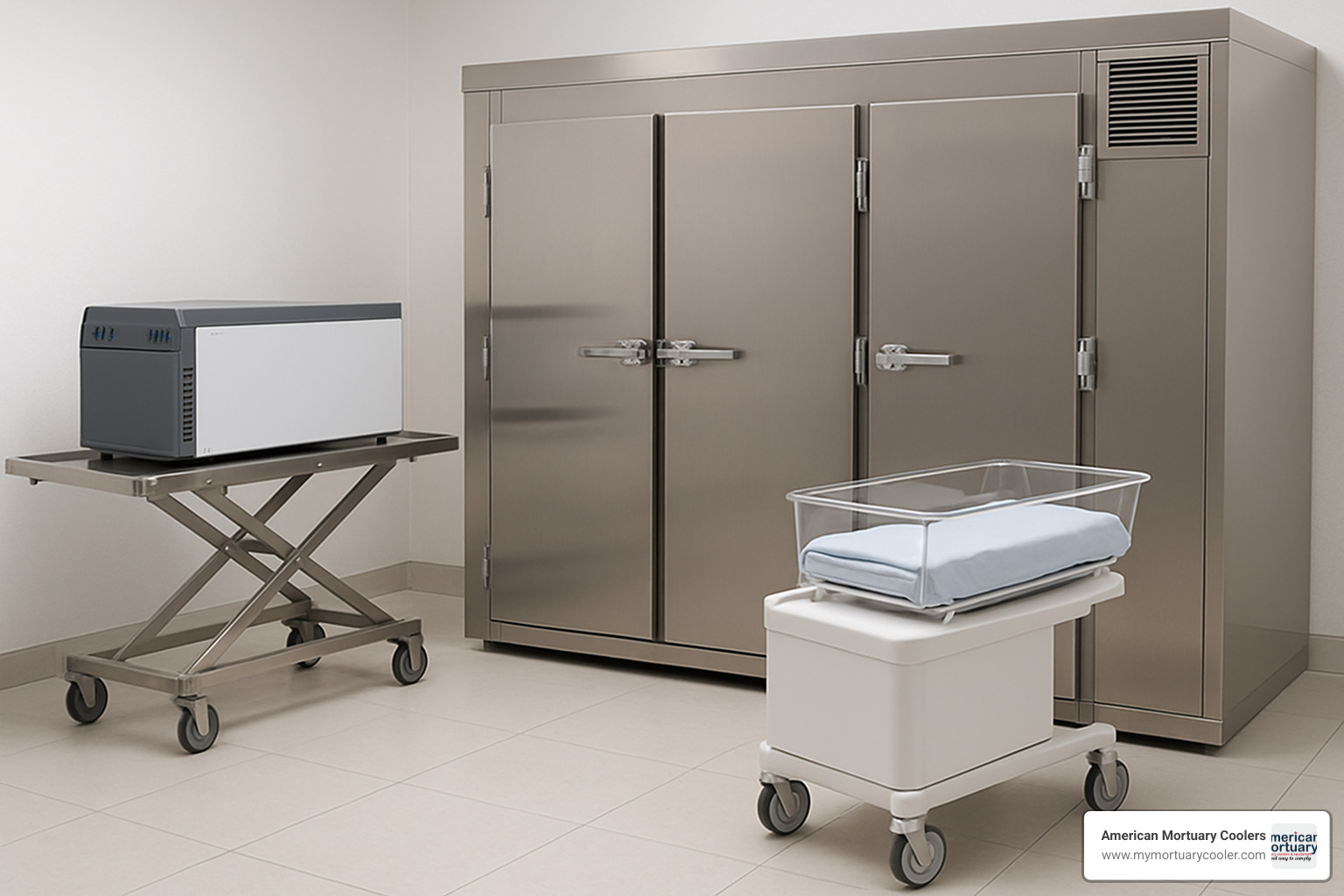
Walk-In Coolers
When it comes to high-volume facilities, walk-in coolers remain the gold standard. These permanent installations are workhorses that provide reliable cooling day in and day out. A typical walk-in cooler features multi-tier shelving systems that can accommodate 12 or more bodies, with slide-out trays that make access easier and reduce the need for excessive handling.
Modern walk-ins come equipped with digital temperature monitoring and alert systems that provide peace of mind. The construction is built to last, with heavy-duty, chrome-plated hardware that stands up to daily use. The walls and floors are well-insulated, with R-values specifically chosen to maximize energy efficiency.
Here's something many funeral directors don't realize: a standard 8'x12' walk-in cooler can hold up to 25 bodies. And when paired with alternative cooling technology like CoolBot systems, the cost can be dramatically reduced to around $5,000—significantly less than traditional compressor-based setups.
Body Boxes
For smaller facilities or those needing flexibility, body boxes offer a practical solution. These self-contained units are perfect for funeral homes with limited space or inconsistent volume. They simply plug into standard 110V outlets, require no special wiring or external drainage, and many models come with castors for easy mobility.
Body boxes typically hold between 1-6 bodies depending on the model you choose. They're particularly popular in rural settings where case volume might not justify a full walk-in cooler. Removal companies also appreciate their compact footprint, and many funeral homes keep one on hand for overflow capacity during busy periods.
Innovative Cooling Technologies
The past decade has brought remarkable innovations to the mortuary cooling systems landscape. Perhaps the most touching advancement has been the development of specialized systems like the CuddleCot and CuddleBlanket, which provide gentle cooling for infants and adults. These systems have transformed the grieving process, allowing families precious additional time with their loved ones.
For mass fatality response, the MERC System has been revolutionary. This liquid-based direct contact cooling can handle up to 48 bodies and be up and running in under 15 minutes—crucial during disaster situations.
Thermoelectric cooling technology has also gained traction. Using the Peltier effect rather than traditional refrigeration, these systems offer lower maintenance and operational costs, with fewer moving parts to break down.
Budget-conscious facilities have acceptd CoolBot Systems, which cleverly convert standard air conditioners into effective mortuary coolers at a fraction of traditional costs. It's a perfect example of how innovation doesn't always need to be complicated to be effective.
For a deeper dive into all available options, take a look at Different Types of Mortuary Coolers.
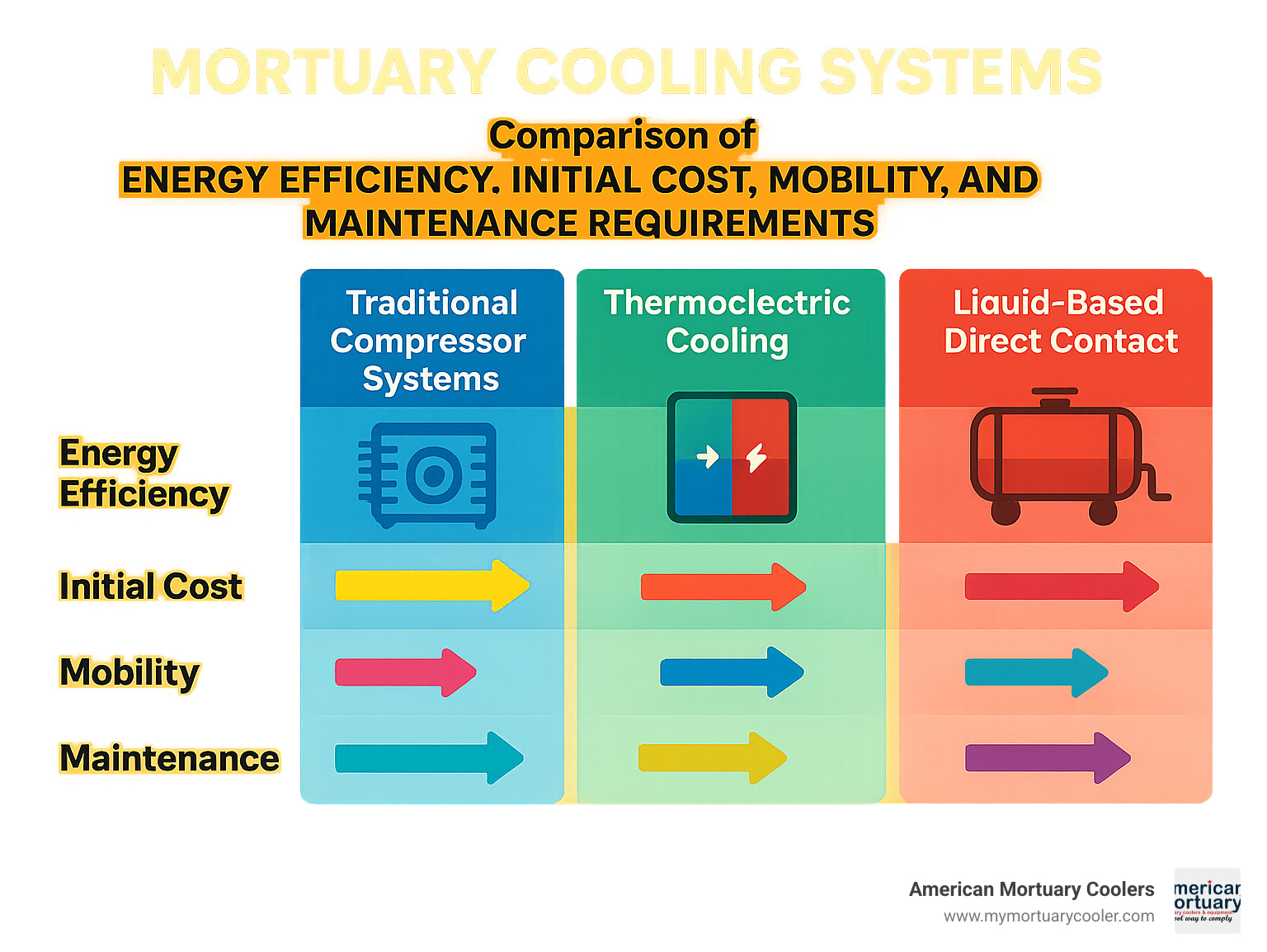
Traditional Air Refrigeration vs Thermoelectric Systems
When choosing between traditional compressor-based refrigeration and newer thermoelectric systems, there's no one-size-fits-all answer. Each has its strengths and ideal applications.
Traditional compressor systems excel at cooling larger spaces and have a well-established track record with readily available parts. However, they do consume more energy, have more mechanical components that may require maintenance, and generate both noise and heat.
Thermoelectric (Peltier) systems, on the other hand, operate with virtually no noise since they have no moving parts. This not only creates a more peaceful environment but also means less maintenance over time. They're lighter, more portable, and use less energy when cooling individual bodies. The main limitation is their reduced capacity for cooling larger spaces.
At American Mortuary Coolers, we believe in matching the right technology to each facility's unique needs. We'll help you consider your case volume, available space, and budget to determine which approach makes the most sense for your situation.
Liquid-Based Direct Contact Systems and Mass Fatality Response
The development of liquid-based direct contact cooling has been a game-changer for mass fatality response. Systems like the MERC (Mortuary Improved Remains Cooling) offer capabilities that were unimaginable just a generation ago.
Unlike air-based cooling that must chill an entire room, these systems make direct contact with the body, providing much faster core temperature reduction. They're remarkably portable and can transform almost any space—warehouses, gymnasiums, tents, even parking lots—into functional temporary morgues.
The scalability is impressive, with capacity ranging from 8 to 48 bodies per system. Perhaps most importantly, they can be operational in under 15 minutes when time is of the essence. Their energy requirements are also lower than cooling entire rooms, making them more practical during emergency situations when resources may be limited.
These innovations have fundamentally changed how we respond to natural disasters, pandemics, and other mass casualty events, allowing for more dignified care even in the most challenging circumstances.
Portable & Flexible Solutions: Benefits and Limitations
Portable cooling solutions like the CuddleBlanket have created new possibilities for both families and funeral professionals. These lightweight systems (about 11kg) can be deployed in seconds, allowing cooling to begin immediately at the place of death rather than waiting for transportation.
For families seeking a more intimate experience, these systems enable longer time with deceased loved ones in familiar surroundings. They've been particularly meaningful for home vigils and green burial practices, where families desire natural care while still meeting practical preservation needs.
Specialized versions are available for unique situations, including bariatric cases and infant deaths. The CuddleCot for babies has been especially impactful, giving parents precious additional hours or days with their child.
While these portable systems offer remarkable flexibility, they do have limitations. They're designed for single-body use, require periodic monitoring, and may not meet all regulatory requirements for long-term storage. They also represent a higher per-body cost compared to multi-body systems.
Despite these considerations, portable cooling options have filled an important gap in the spectrum of mortuary cooling systems, providing solutions that better serve the emotional needs of families while meeting practical preservation requirements.
Selecting, Operating & Maintaining Your System
Choosing the right mortuary cooling system isn't just about refrigeration—it's about finding a solution that respects your work, your space, and the families you serve. At American Mortuary Coolers, we walk alongside our clients through this important decision, helping you balance practical needs with long-term value.
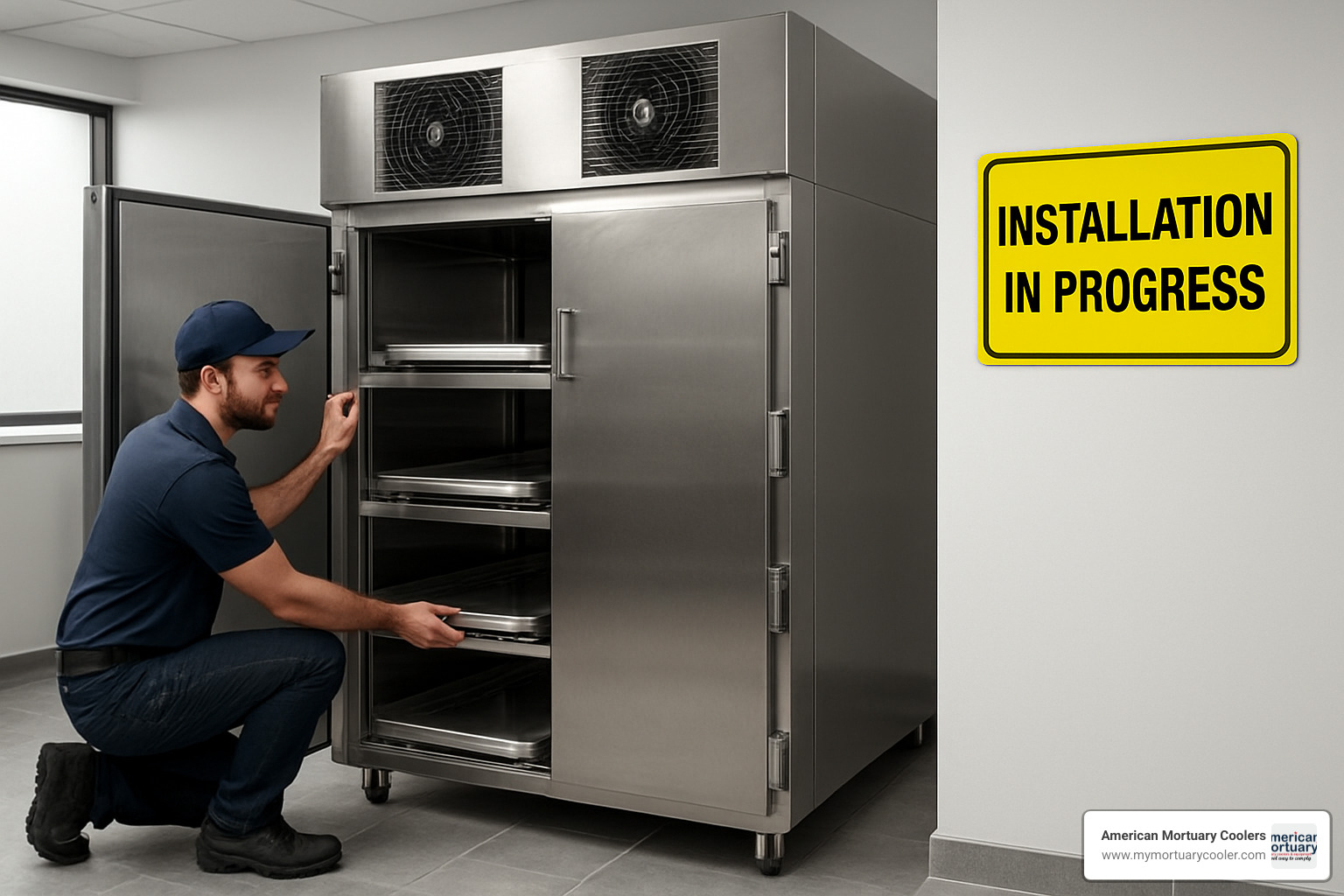
Calculating Storage Capacity and Floor Space
When funeral directors ask me about sizing, I often say, "Plan for your busiest week, not your average day." This simple wisdom has saved many facilities from the stress of inadequate capacity during unexpected surges.
Start by analyzing your historical case volume, particularly noting those seasonal peaks or unusual periods. A good rule of thumb? Plan for about 150% of your average daily case load. This gives you breathing room when you need it most.
Space-saving is an art in itself. Vertical storage solutions—whether multi-tier shelving in walk-ins or stacked body boxes—can transform a modest footprint into a surprisingly capable facility. Just remember that your staff needs enough room to work safely and with dignity.
The beauty of our modular panel systems is their ability to grow with you. I typically recommend purchasing a system with 20-30% more capacity than your current needs—it's much easier than scrambling for overflow solutions later. Many of our clients who've been in business for decades tell me their only regret was not going bigger from the start.
For more detailed planning guidance, our resource on The Ultimate Guide to Choosing a Walk-In Mortuary Cooler walks through the process step by step.
Energy Costs and Insulation Best Practices
The conversation about cooling systems often focuses on purchase price, but the real story unfolds in your monthly energy bills over years of operation.
Insulation quality makes all the difference. Our systems use expanded or extruded polystyrene with R-values specifically optimized for mortuary applications. Think of good insulation as an investment that pays dividends every month on your utility bill.
Your climate zone matters tremendously. A system in sun-baked Phoenix faces different challenges than one in rainy Seattle. We customize our recommendations based on your location's temperature extremes and humidity patterns.
Here's an insider tip that's saved our clients thousands: larger units generally offer better energy efficiency per body than smaller ones—but only when properly used. An oversized, half-empty cooler wastes energy cooling unused space.
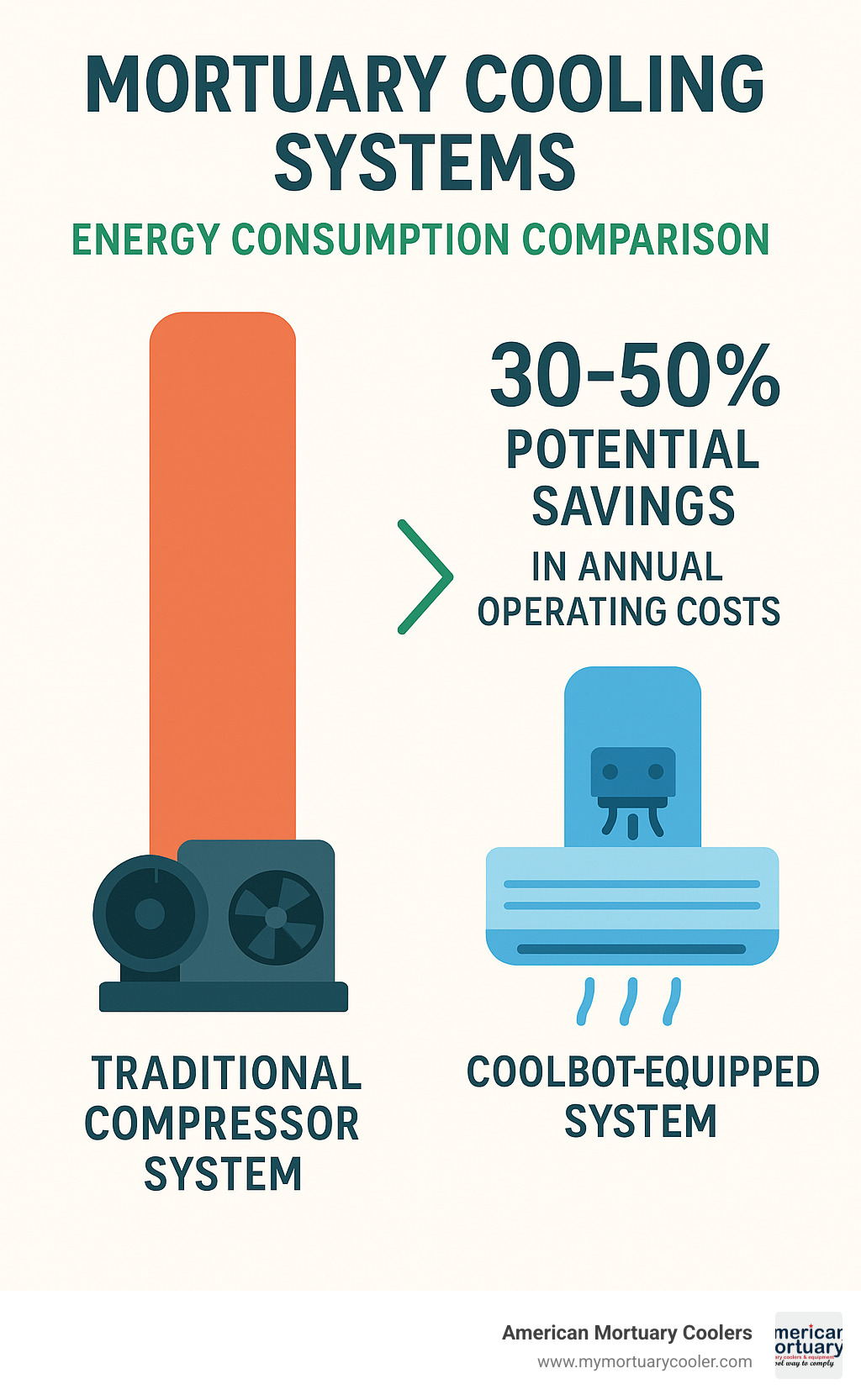
Many budget-conscious facilities have found remarkable savings with our CoolBot systems. By cleverly modifying residential air conditioners, these systems can slash both initial costs and ongoing energy expenses by 30-50%. For smaller operations, this technology has been nothing short of transformative.
Daily Operation, Cleaning, and Long-Term Durability
The most expensive cooler is the one that fails when you need it most. That's why we emphasize practical, consistent maintenance routines.
For daily operations, simple habits make all the difference. Check your digital thermometers daily—just a quick glance to confirm proper temperature. Be mindful of door openings; each time that door swings open, you're letting cold air escape and warm air enter. Train staff to plan their tasks to minimize entry times.
Door gaskets deserve special attention—they're the unsung heroes of energy efficiency. A quick visual inspection for cracks or wear takes seconds but can prevent temperature fluctuations and energy waste.
When it comes to cleaning, mortuary environments demand hospital-grade standards. Use disinfectants specifically approved for mortuary settings, and address any spills immediately. This isn't just about appearances—it's about preventing corrosion that can shorten your equipment's lifespan and avoiding cross-contamination issues.
We've seen systems last 20+ years with proper care, particularly when owners follow our recommendations for professional service at six-month intervals. These check-ups catch small issues before they become expensive problems. Quarterly condenser coil cleaning and annual inspection of weatherproofing on outdoor units are simple steps that yield big dividends in equipment longevity.
Every American Mortuary Cooler comes with straightforward maintenance guides written in plain English, not technical jargon. We believe good maintenance shouldn't require an engineering degree.
Choosing Support, Service, and Customization
The relationship with your cooler provider shouldn't end at delivery. In fact, that's when the most important part begins.
Our 24/7 technical support isn't staffed by script-readers—you'll speak with experienced professionals who understand the unique urgency of funeral service. When you call at 2 AM because something doesn't sound right, you need answers, not hold music.
We stand behind our products with substance, not just slogans. Our 15-year warranty on panels and doors and 5-year coverage on mechanical components reflect our confidence in what we build. We've heard too many stories of funeral directors left hanging when cheaper units failed prematurely.
Customization is where we truly shine. From specialized flooring materials that improve durability to custom shelving configurations that maximize your specific space, we build systems that work for your unique facility. One funeral home in New Orleans needed a system that could handle extreme humidity while fitting into a historic building with strict preservation requirements—challenges like these are where custom solutions prove their worth.
With service teams in major cities including Atlanta, Chicago, Dallas, and New York, American Mortuary Coolers provides responsive support nationwide. We're never more than a day's drive from your facility, regardless of which of the contiguous 48 states you call home.
To learn more about our approach to supporting funeral professionals nationwide, visit our article on Keeping Cool: The Vital Role of Mortuary Coolers Nationwide.
Frequently Asked Questions about Mortuary Cooling Systems
What temperature should a mortuary cooler maintain?
When families ask me about temperatures for mortuary cooling systems, I always emphasize the importance of the 36-39°F (2-4°C) sweet spot. This isn't just an arbitrary range—it's carefully chosen to balance preservation needs with practical considerations.
At this temperature, decomposition processes slow dramatically without causing tissue freezing that could affect the appearance of your loved one. Most funeral directors I work with appreciate how this range makes embalming more effective while creating a comfortable environment for staff performing their sacred duties.
For those working in forensic settings or medical examiner offices, you might need colder temperatures—sometimes even below freezing—especially when long-term preservation is necessary for evidence or when identification might be delayed. Our systems can be calibrated for these specialized needs while maintaining precise temperature control.
How often should I service my mortuary cooling system?
Think of your mortuary cooling system like your car—regular maintenance prevents unexpected breakdowns when you need it most. I recommend a simple but effective schedule to my clients:
Every three months, take time to clean those condenser coils (they collect dust!), check refrigerant levels, and inspect door gaskets for any signs of wear. These quick checks can prevent most common issues.
Twice yearly, it's worth having a professional service technician perform a more thorough evaluation of electrical components and control systems. Many of our customers schedule these visits in spring and fall, before the summer heat and winter cold put extra demands on their systems.
Once a year, invest in a comprehensive system evaluation that includes checking insulation integrity and structural components. The digital monitoring systems we install can provide early warnings between these scheduled maintenance visits, giving you peace of mind that your system is functioning properly.
Can portable cooling blankets replace a walk-in cooler?
I'm often asked if solutions like our CuddleBlanket can completely replace traditional walk-in coolers. The honest answer is that they serve different but complementary purposes.
Portable cooling blankets truly shine when families want more time with their loved one, especially in home settings. They're perfect for those embracing green burial practices or when immediate cooling is needed at the place of death. The dignity and comfort they provide families can't be overstated.
However, for daily operations at most funeral homes, walk-in coolers remain essential. They're typically required for regulatory compliance, they efficiently handle multiple bodies during busy periods, and they provide the consistent cooling needed for longer-term care.
Many of the funeral directors I work with have found that having both options available gives them flexibility to serve families in more personalized ways. A family might appreciate their loved one being cared for in a walk-in cooler overnight, then transferred to a portable cooling blanket for a more intimate family viewing the next day.
At American Mortuary Coolers, we're happy to help you determine the right mix of cooling solutions based on your facility's unique needs and the families you serve.
Conclusion
When it comes to honoring those who have passed, every detail matters. Mortuary cooling systems aren't just technical equipment—they represent our commitment to dignity, care, and respect during life's most difficult moments.
Here at American Mortuary Coolers, we take pride in crafting cooling solutions that go beyond mere functionality. Our custom-built systems are designed with the unique challenges of funeral professionals in mind, whether you're serving families in a busy city funeral home or a quiet rural community. From Tennessee to Texas, from Florida to Washington, our nationwide delivery ensures quality cooling systems reach funeral homes, hospitals, and medical examiners across all 48 contiguous states.
I've seen how the right cooling system makes all the difference—not just in meeting regulations, but in giving funeral directors peace of mind so they can focus on what truly matters: supporting grieving families. The evolution from basic refrigeration to today's innovative solutions reflects our industry's beautiful balance of technical advancement and compassionate service.
For some facilities, a traditional walk-in cooler provides the reliability and capacity needed for day-to-day operations. For others, newer technologies like portable cooling blankets offer flexibility for home viewings or green burial practices. Many find that a combination works best, adapting to different situations while maintaining the highest standards of care.
What makes me most proud about our work at American Mortuary Coolers isn't just the quality of our equipment—it's knowing that behind every installation is a team of dedicated professionals who will use these tools to provide meaningful, respectful care during life's most challenging moments.
Whether you're expanding your current facility, replacing aging equipment, or starting fresh, we're here to help you find the perfect cooling solution that honors both the practical and compassionate aspects of your important work.


















